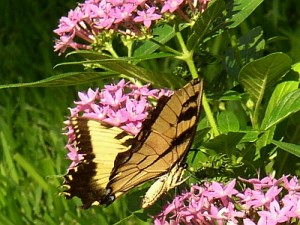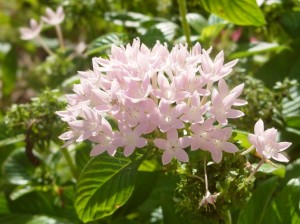Plant of the Week
September 16, 2006
 Butterfly Pentas are a fast and easy way to decorate your patios, decks, or to add that special color to your garden border. Pentas make a choice nectar plant for a butterfly garden or an excellent plant for cut flowers. They make attractive container plants and component plants for combination plantings. A colorful landscape combination would include Butterfly Pentas with your choice of color — Plectranthus argentatus with its large silvery foliage for contrast, Angelonia angustifolia, and Pennisetum setaceum ‘Rubrum’ for texture. With Butterfly Pentas planted in your landscape, you will be the envy of the neighborhood. Believe me, the increase in your butterfly and hummingbird population will also make you happy.
Butterfly Pentas are a fast and easy way to decorate your patios, decks, or to add that special color to your garden border. Pentas make a choice nectar plant for a butterfly garden or an excellent plant for cut flowers. They make attractive container plants and component plants for combination plantings. A colorful landscape combination would include Butterfly Pentas with your choice of color — Plectranthus argentatus with its large silvery foliage for contrast, Angelonia angustifolia, and Pennisetum setaceum ‘Rubrum’ for texture. With Butterfly Pentas planted in your landscape, you will be the envy of the neighborhood. Believe me, the increase in your butterfly and hummingbird population will also make you happy.
 Pentas are a multi-stemmed plant with a bushy, rounded habit. The foliage is deep green with light fuzzy hairs on the surface of the leaf. The small, star-shaped tubular flowers form in large umbels up to 3 inches across. Butterfly Pentas are also called ”Egyptian Starflowers.” A single plant may produce 15 to 20 flower clusters at one time. These plants flower continuously from spring to autumn, with nectar from the flowers that attract swarms of butterflies and hummingbirds.
Pentas are a multi-stemmed plant with a bushy, rounded habit. The foliage is deep green with light fuzzy hairs on the surface of the leaf. The small, star-shaped tubular flowers form in large umbels up to 3 inches across. Butterfly Pentas are also called ”Egyptian Starflowers.” A single plant may produce 15 to 20 flower clusters at one time. These plants flower continuously from spring to autumn, with nectar from the flowers that attract swarms of butterflies and hummingbirds.
There are many Pentas cultivars on the market today. Some are propagated by cuttings, like ‘Ruby Glow’ and ‘Pink Profusion’, and there are series of seed-produced Pentas such as the ‘New Look’ series from Benary Seed Company and the ‘Butterfly’ series from Pan American Seed Company. Check it out!
Butterfly Pentas prefer full sun in a moist well-drained area or a raised bed that has been enriched with liberal amounts of organic matter. Use a 2 to 4 inch layer of an organic hardwood mulch around individual plants. This will conserve moisture in the soil; however Butterfly Pentas do not like soggy soil for any extended period of time. Fertilize often with a well-balanced, all-purpose fertilizer such as a 6-2-4 or 4-2-3 analysis. Prune or pinch lightly in early spring to promote branching, which will enhance more abundant and better quality flower stems. Pinch or “deadhead” spent flower heads regularly to promote future blooms. Plants should be spaced every 18-24 inches apart at planting.
Plant Type: Perennial in zone 9-10 are usually grown as an annual.
Uses: Garden borders, cut flower garden, containers and butterfly gardens.
Habit: Round, Spreading. Light: Full Sun Flower.
Colors: Blush (light pink to white), cherry red, deep pink, light lavender, and red.
Bloom Time: Spring, summer, early autumn.
Size: Width: 1.5 ft.,Height: 1.5-2 ft.
Garden Spacing: 15” apart.
Food: Feed regularly with an all-purpose fertilizer.
Soil: Deeply cultivated, fertile, well-drained soil.
Common Problems: Aphids, thrips and whitefly.
Attracts: Butterflies as well as bees and hummingbirds.
Remember, Learn and Have Fun!!!
David Rodriguez is the County Extension Agent-Horticulture for Bexar County. He represents Texas Cooperative Extension with the Texas A&M University System. For any landscape or gardening information, call the Bexar County Master Gardeners Hotline at (210) 467-6575, email questions to mg-bexar@tamu.edu, or visit our County Extension website at http://bexar-tx.tamu.edu/
Special Note: Listen to live broadcast of the Home & Garden Show with David Rodriguez & Bill Rohde on WOAI 1200 AM, every Saturday morning between 8:00-11:00 a.m., and call in your gardening questions at (210) 737-1200 or 1-800-383-9624. Check it out!